Abstract
The carcinogenic potentials of 40 National Toxicology Program chemicals previously predicted by Computer Optimised Molecular Parametric Analysis for Chemical Toxicity (COMPACT), based on the identification of potential substrates of cytochromes P4501A and 2E (CYP1A and CYP2E), have been compared with new rodent carcinogenicity results. The COMPACT predictions have also been compared with published Ames mutagenicity data and with our own Hazardexpert predictions for carcinogenicity. Concordance evaluations between rodent carcinogenicity (1/4 segments positive) and predictions by COMPACT or Hazardexpert were 64% for COMPACT (CYP1A only), 72% for COMPACT (CYP1A plus CYP2E), 70% for Hazardexpert alone, and 86% for COMPACT (CYP1A plus CYP2E) plus Hazardexpert. Sensitivities of the predictions were for COMPACT, 75%; Hazardexpert, 60%; and Ames, 54%. Positive predictivities were for COMPACT, 75%; Hazardexpert, 78%; and Ames 81%. Negative predictivites were for COMPACT, 62%; Hazardexpert, 52%; and Ames, 42%.
Full text
PDF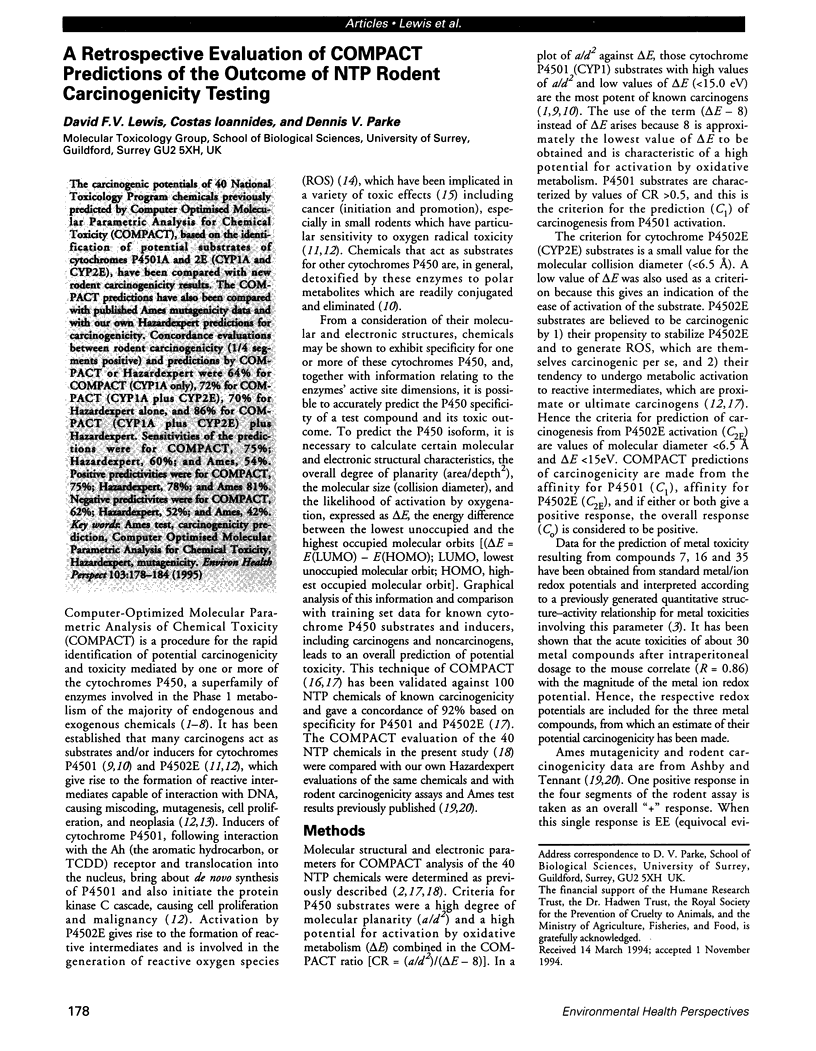
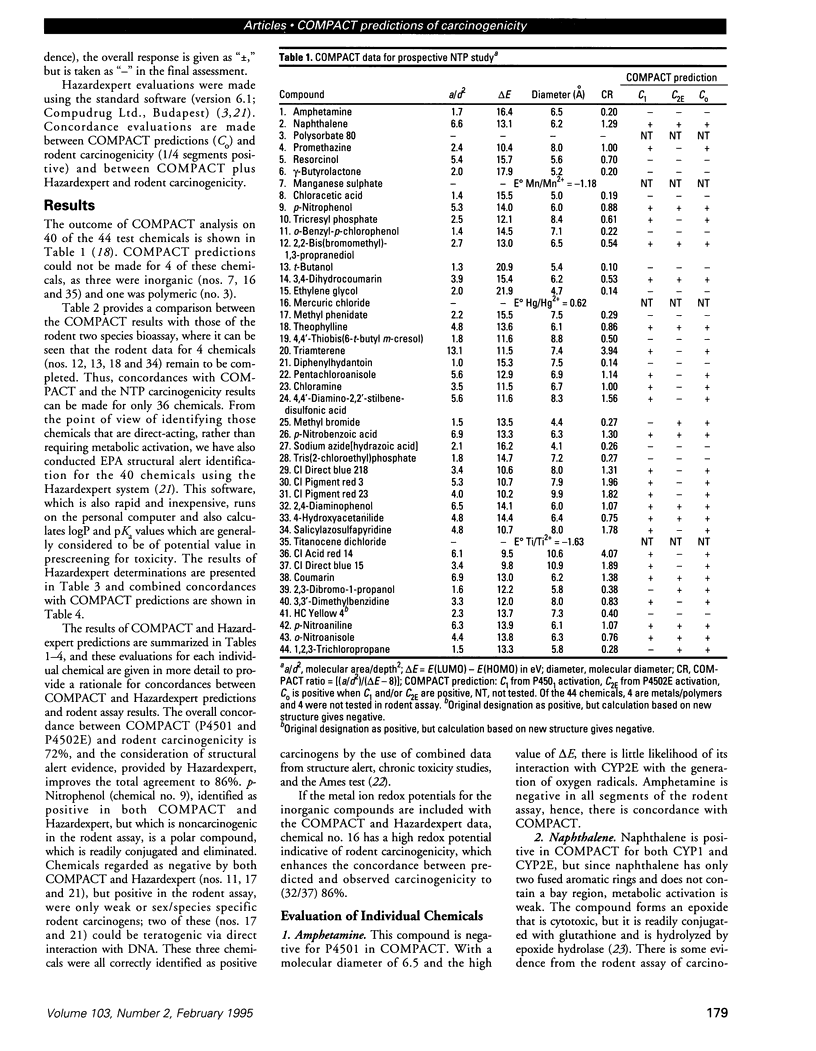
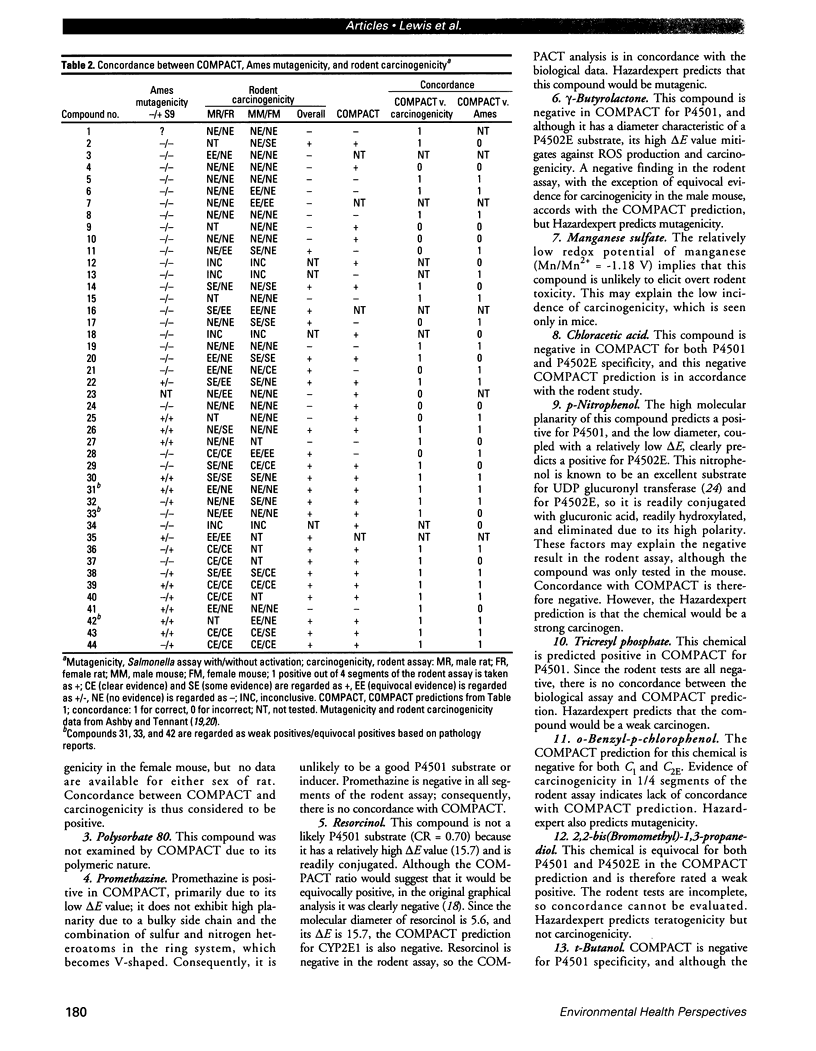
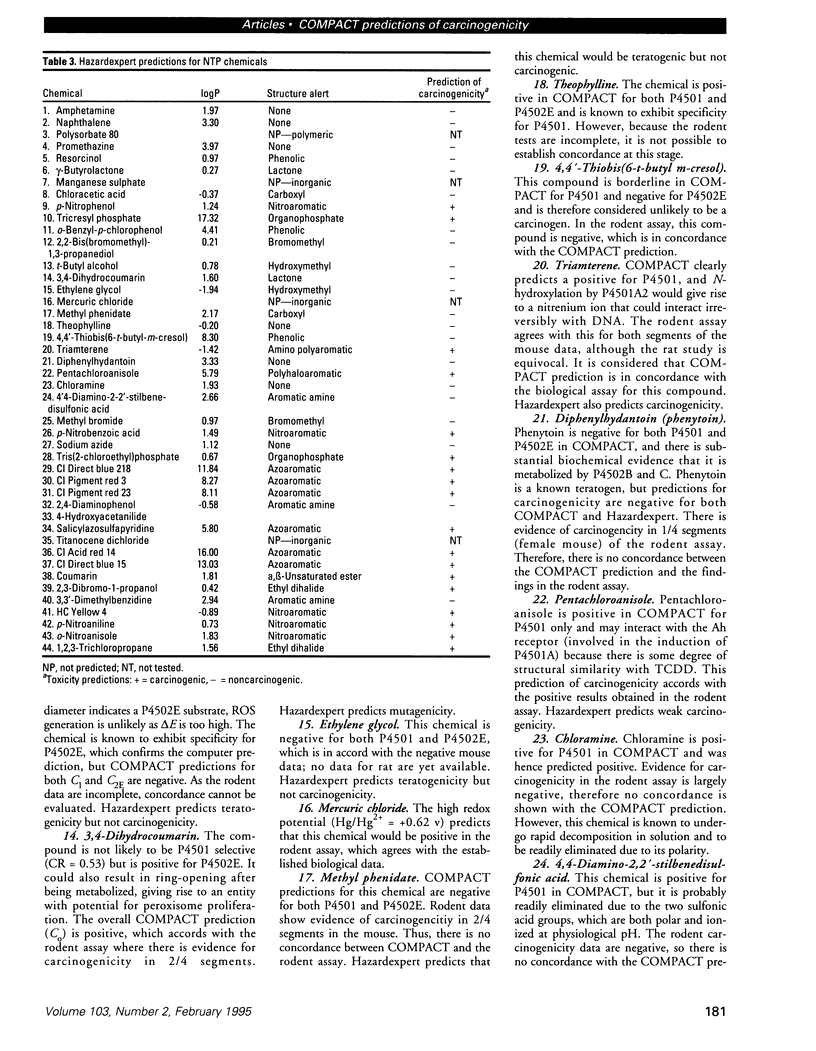
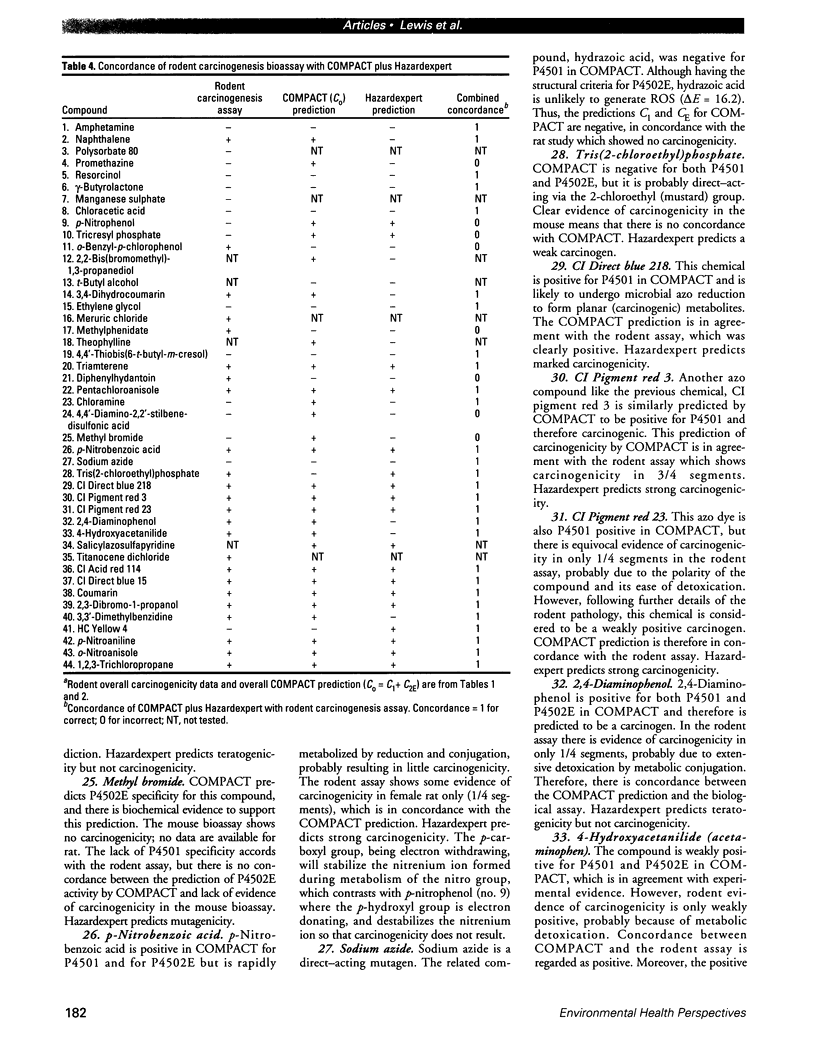
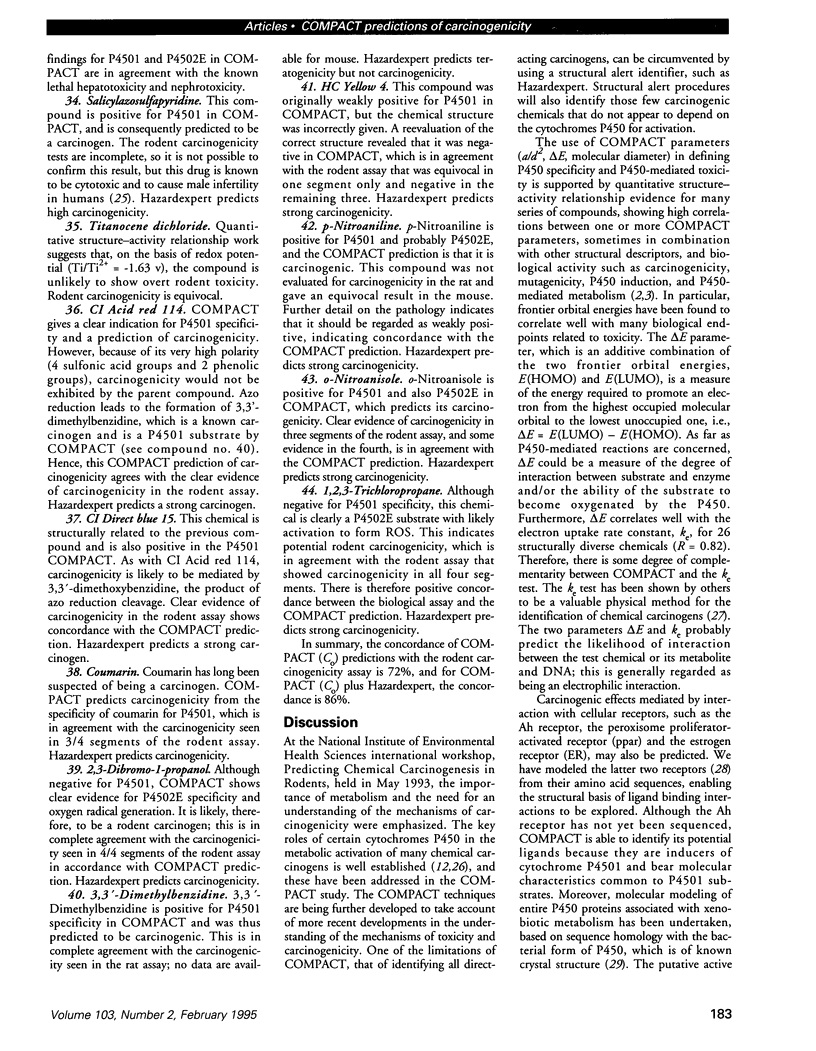
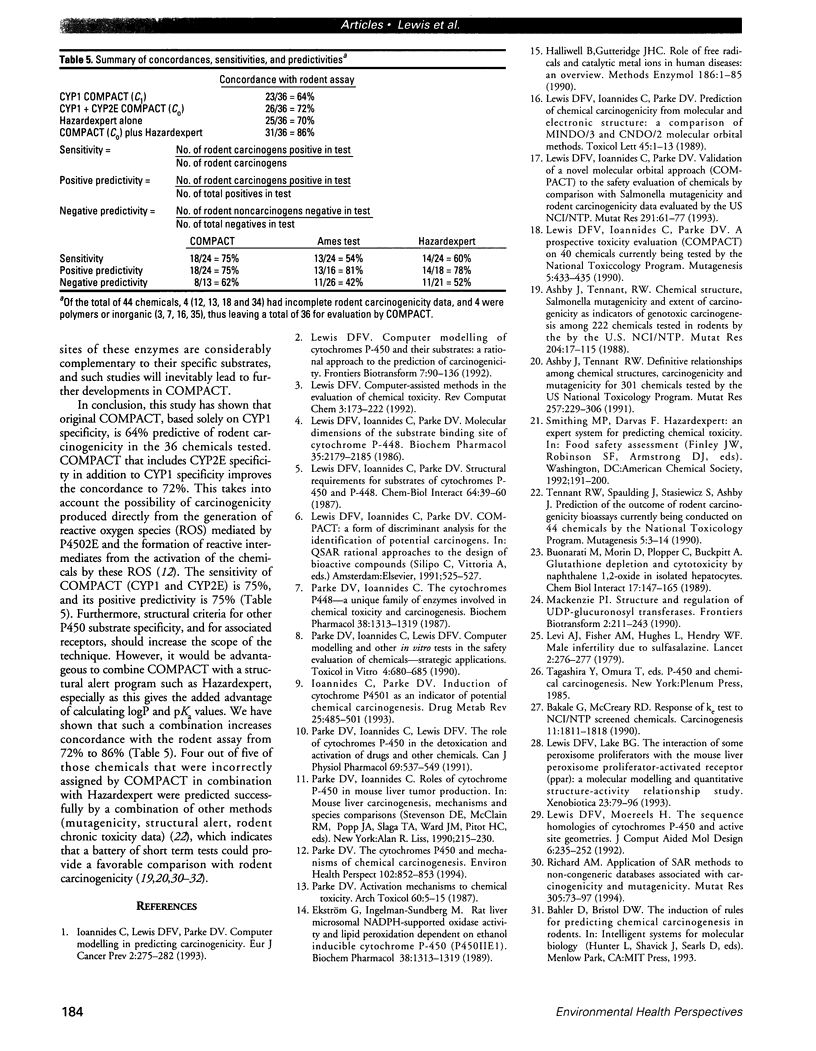
Selected References
These references are in PubMed. This may not be the complete list of references from this article.
- Ashby J., Tennant R. W. Chemical structure, Salmonella mutagenicity and extent of carcinogenicity as indicators of genotoxic carcinogenesis among 222 chemicals tested in rodents by the U.S. NCI/NTP. Mutat Res. 1988 Jan;204(1):17–115. doi: 10.1016/0165-1218(88)90114-0. [DOI] [PubMed] [Google Scholar]
- Ashby J., Tennant R. W. Definitive relationships among chemical structure, carcinogenicity and mutagenicity for 301 chemicals tested by the U.S. NTP. Mutat Res. 1991 May;257(3):229–306. doi: 10.1016/0165-1110(91)90003-e. [DOI] [PubMed] [Google Scholar]
- Bakale G., McCreary R. D. Response of the ke test to NCI/NTP-screened chemicals. I. Non-genotoxic carcinogens and genotoxic non-carcinogens. Carcinogenesis. 1990 Oct;11(10):1811–1818. doi: 10.1093/carcin/11.10.1811. [DOI] [PubMed] [Google Scholar]
- Buonarati M., Morin D., Plopper C., Buckpitt A. Glutathione depletion and cytotoxicity by naphthalene 1,2-oxide in isolated hepatocytes. Chem Biol Interact. 1989;71(2-3):147–165. doi: 10.1016/0009-2797(89)90031-8. [DOI] [PubMed] [Google Scholar]
- Ekström G., Ingelman-Sundberg M. Rat liver microsomal NADPH-supported oxidase activity and lipid peroxidation dependent on ethanol-inducible cytochrome P-450 (P-450IIE1). Biochem Pharmacol. 1989 Apr 15;38(8):1313–1319. doi: 10.1016/0006-2952(89)90338-9. [DOI] [PubMed] [Google Scholar]
- Halliwell B., Gutteridge J. M. Role of free radicals and catalytic metal ions in human disease: an overview. Methods Enzymol. 1990;186:1–85. doi: 10.1016/0076-6879(90)86093-b. [DOI] [PubMed] [Google Scholar]
- Ioannides C., Lewis D. F., Parke D. V. Computer modelling in predicting carcinogenicity. Eur J Cancer Prev. 1993 May;2(3):275–282. doi: 10.1097/00008469-199305000-00015. [DOI] [PubMed] [Google Scholar]
- Ioannides C., Parke D. V. Induction of cytochrome P4501 as an indicator of potential chemical carcinogenesis. Drug Metab Rev. 1993;25(4):485–501. doi: 10.3109/03602539308993983. [DOI] [PubMed] [Google Scholar]
- Levi A. J., Fisher A. M., Hughes L., Hendry W. F. Male infertility due to sulphasalazine. Lancet. 1979 Aug 11;2(8137):276–278. doi: 10.1016/s0140-6736(79)90292-7. [DOI] [PubMed] [Google Scholar]
- Lewis D. F., Ioannides C., Parke D. V. A prospective toxicity evaluation (COMPACT) on 40 chemicals currently being tested by the National Toxicology Program. Mutagenesis. 1990 Sep;5(5):433–435. doi: 10.1093/mutage/5.5.433. [DOI] [PubMed] [Google Scholar]
- Lewis D. F., Ioannides C., Parke D. V. Molecular dimensions of the substrate binding site of cytochrome P-448. Biochem Pharmacol. 1986 Jul 1;35(13):2179–2185. doi: 10.1016/0006-2952(86)90589-7. [DOI] [PubMed] [Google Scholar]
- Lewis D. F., Ioannides C., Parke D. V. Prediction of chemical carcinogenicity from molecular and electronic structures: a comparison of MINDO/3 and CNDO/2 molecular orbital methods. Toxicol Lett. 1989 Jan;45(1):1–13. doi: 10.1016/0378-4274(89)90153-7. [DOI] [PubMed] [Google Scholar]
- Lewis D. F., Ioannides C., Parke D. V. Structural requirements for substrates of cytochromes P-450 and P-448. Chem Biol Interact. 1987;64(1-2):39–60. doi: 10.1016/0009-2797(87)90059-7. [DOI] [PubMed] [Google Scholar]
- Lewis D. F., Ioannides C., Parke D. V. Validation of a novel molecular orbital approach (COMPACT) for the prospective safety evaluation of chemicals, by comparison with rodent carcinogenicity and Salmonella mutagenicity data evaluated by the U.S. NCI/NTP. Mutat Res. 1993 Feb;291(1):61–77. doi: 10.1016/0165-1161(93)90018-u. [DOI] [PubMed] [Google Scholar]
- Lewis D. F., Lake B. G. Interaction of some peroxisome proliferators with the mouse liver peroxisome proliferator-activated receptor (PPAR): a molecular modelling and quantitative structure-activity relationship (QSAR) study. Xenobiotica. 1993 Jan;23(1):79–96. doi: 10.3109/00498259309059364. [DOI] [PubMed] [Google Scholar]
- Lewis D. F., Moereels H. The sequence homologies of cytochromes P-450 and active-site geometries. J Comput Aided Mol Des. 1992 Jun;6(3):235–252. doi: 10.1007/BF00123379. [DOI] [PubMed] [Google Scholar]
- Parke D. V. Activation mechanisms to chemical toxicity. Arch Toxicol. 1987;60(1-3):5–15. doi: 10.1007/BF00296939. [DOI] [PubMed] [Google Scholar]
- Parke D. V., Ioannides C., Lewis D. F. The 1990 Pharmaceutical Manufacturers Association of Canada keynote lecture. The role of the cytochromes P450 in the detoxication and activation of drugs and other chemicals. Can J Physiol Pharmacol. 1991 May;69(5):537–549. doi: 10.1139/y91-081. [DOI] [PubMed] [Google Scholar]
- Parke D. V. The cytochromes P450 and mechanisms of chemical carcinogenesis. Environ Health Perspect. 1994 Oct;102(10):852–853. doi: 10.1289/ehp.94102852. [DOI] [PMC free article] [PubMed] [Google Scholar]
- Richard A. M. International Commission for Protection Against Environmental Mutagens and Carcinogens. Application of SAR methods to non-congeneric data bases associated with carcinogenicity and mutagenicity: issues and approaches. Mutat Res. 1994 Feb 1;305(1):73–97. doi: 10.1016/0027-5107(94)90127-9. [DOI] [PubMed] [Google Scholar]
- Tennant R. W., Spalding J., Stasiewicz S., Ashby J. Prediction of the outcome of rodent carcinogenicity bioassays currently being conducted on 44 chemicals by the National Toxicology Program. Mutagenesis. 1990 Jan;5(1):3–14. doi: 10.1093/mutage/5.1.3. [DOI] [PubMed] [Google Scholar]


